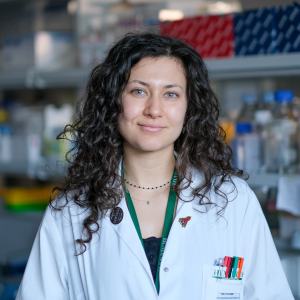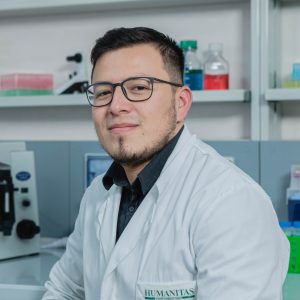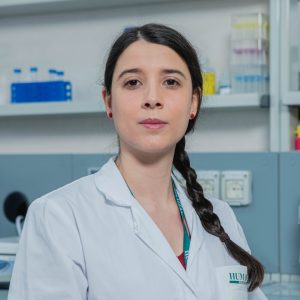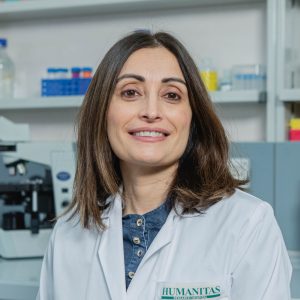Research Group
Vetrano Group
Gastrointestinal Immunopathology Lab
Our lab is dedicated to the study of the interplay between cellular and molecular mechanisms underlying complex processes involved in regulation of inflammation, tissue repair, and remodeling in gastrointestinal inflammatory diseases. Our aim is the unraveling of the disease pathogenesis and enabling potential preventive strategies for associated complications
The Challenge
Ulcerative Colitis and Crohn’s Disease are the two main conditions of Inflammatory Bowel Disease (IBD) which are characterized by chronic inflammation of the gut and for which there is no cure or biomarker for disease monitoring. Continuous insults to the intestinal mucosa, an aberrant tissue repair mechanism and a dysregulated immune system result in complications such as fistula formation and intestinal fibrosis, leading to strictures and consequent intestinal obstruction and surgical intervention. Our group focuses in deciphering cellular and molecular intricacies involved in IBD to shed light onto disease pathogenesis and progression, the effect of diet, the underlying mechanisms of current therapies and the use of novel technologies for biomarker discovery. We pursue the goal of identifying new therapeutic targets that resolve and prevent fibrosis and prognostic biomarkers to stratify patients according to treatment response and prognosis utilizing in-vitro, in-vivo, ex-vivo and in-silico approaches.
Main Research Areas
S1P Receptors (S1PR) in the gut: fibrosis and mucosal regeneration in IBD
Sphingosine-1-phosphate (S1P) is a signaling lipid that regulates multiple cellular processes in mammals. The S1P/S1PRs axis orchestrates several biological processes such as inflammation, proliferation, differentiation, endothelial barrier permeability and cell migration, and its role in lymphocyte trafficking is well known. However, its implications in other non-immune cells is yet to be elucidated. We work towards deciphering the mechanisms of S1P/S1PRs involved in gut fibrosis and mucosal regeneration and how current therapies modulate this axis.
The role of diet in intestinal fibrosis and tumor development
Based on epidemiological evidences, westernization of lifestyle with a change in diet from the Mediterranean pattern to a diet rich in saturated and hydrogenated fatty acids has gone hand in hand with an increase of incidence and prevalence of Crohn’s disease in the population. However, the impact of dietary nutrients, and in particular, a high-fat diet on the development of complications associated to this disease has not been studied. Our mission is to shed light on the underlying pathways that precede the clinical phenotype, which may lead to preventive and therefore more efficacious intervention with the natural course of disease, or alternatively, the development of therapeutic strategies.
B cells and their role in intestinal fibrosis
The role of T-cells in the fibrotic process has been widely investigated, while the role of B-cells remained marginal. To date, B-cells, one of the two main types of lymphocytes of the adaptive immune system involved in the humoral response, are increasingly recognized as novel players driving chronic inflammation in different fibrotic diseases, but their role in intestinal fibrosis has been poorly explored. We aim to explore the involvement of B-cells in the intestinal fibrotic process analyzing the crosstalk between B-cells, epithelial cells and fibroblasts, as key players of intestinal fibrogenesis.
Low-Intensity Pulsed Ultrasound and biomarker identification
Ulcerative colitis diagnosis is currently biomarker independent and relies on a multidisciplinary approach comprising symptomatology evaluation and invasive endoscopic assessment. There is an unmet need for sensitive, and easy-to-detect signatures helping a rapid and non-invasive diagnosis, suitable for monitoring disease progression and response to therapy. The release of biomolecule-carrying extracellular vesicles has been proved enhanced by the application Low-Intensity Pulsed Ultrasounds. We explore this method as gut liquid biopsy able to reflect tissue microenvironment characteristics and novel biomarkers
Extracellular matrix remodeling in intestinal fibrosis
The etiopathogenesis of perianal fistula in Crohn’s diseases is still unknown. However, the mucosa appears infiltrated by inflammatory cells and myofibroblasts that, in the attempt to repair the damaged tissue, deposit collagen and other components of the extracellular matrix (ECM), with consequent tissue remodeling and stiffness. This process is likely due to the epithelial–mesenchymal transition (EMT) of intestinal fibroblasts impairing the ability of these cells to repair mucosal membrane damage. We study and address the dysregulation and pathological ECM organization mediated by TNF-stimulated gene-6, triggering EMT processes, to pave the way for new targets for the treatment of perianal fistula.
Selected publications
Pomegranate Extract Affects Gut Biofilm Forming Bacteria and Promotes Intestinal Mucosal Healing Regulating the Crosstalk between Epithelial Cells and Intestinal Fibroblasts.
Dysfunctional Extracellular Matrix Remodeling Supports Perianal Fistulizing Crohn’s Disease by a Mechanoregulated Activation of the Epithelial-to-Mesenchymal Transition.
Unveiling role of sphingosine-1-phosphate receptor 2 as a brake of epithelial stem cell proliferation and a tumor suppressor in colorectal cancer.
Hyaluronan Accelerates Intestinal Mucosal Healing through Interaction with TSG-6.
TNF-Stimulated Gene-6 Is a Key Regulator in Switching Stemness and Biological Properties of Mesenchymal Stem Cells.
Mesenchymal Stem Cells Reduce Colitis in Mice via Release of TSG6, Independently of Their Localization to the Intestine.
Bacterial sensor triggering receptor expressed on myeloid cells-2 regulates the mucosal inflammatory response.
Unexpected role of anticoagulant protein C in controlling epithelial barrier integrity and intestinal inflammation.
The lymphatic system controls intestinal inflammation and inflammation-associated Colon Cancer through the chemokine decoy receptor D6.
Unique role of junctional adhesion molecule-a in maintaining mucosal homeostasis in inflammatory bowel disease.
Group members









